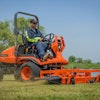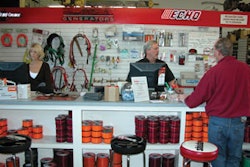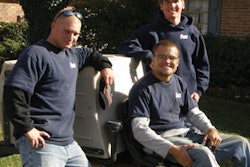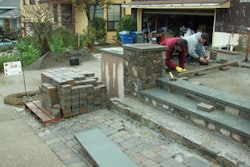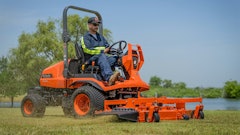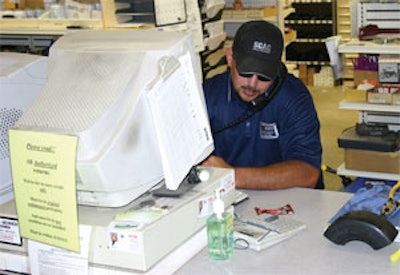
Every outdoor power equipment dealer wants a successful, profitable business. They see to the business’s daily operations, ordering equipment and parts inventory, supervising the staff and servicing the customers. When the year is done, and all the hard work and dedication has hopefully paid off, what now? What do you do with any profit dollars you accrued?
For some dealers, the decision is made before the profit is even earned. Developing an annual business plan is something strongly encouraged by Steve Hoctor, a business development manager for SCOTSCO, an Oregon-based distributor. As part of the company’s dealership training, they assist dealers in developing and refining their business plans, including where and how to invest their profit dollars.
With the numerous factors that influence the success of the seasonal dealership business, it may be difficult to forecast profit earnings. Without specific forecasting, planning for business reinvestment may also be a challenge. It should, however, not be too difficult for a dealer who is very involved in the day-to-day operations of their business to know where it needs investment most. Many distributors, consultants and dealers advise investing money in similar segments of the business.
INVESTING AND BORROWING
Before deciding what to invest in, how much will you invest?
“Dealers should be putting 20 percent of their profit right back into their business,” suggests Hoctor. “The minimum they should invest each year is five percent.”
Mike Marks, from the Indian River Consulting Group, warns dealers not to invest too much too fast. “Many more people go out of business than people think because they have grown too fast,” says Marks. “After a good year they invest to grow their business, but they run out of dough and can’t keep up with it—and it kills them.” Dealers should be cautious when growing and be sure to only invest as much as they can maintain.
Marks suggests making small investments here and there instead of putting all of the investment dollars into one big investment idea. “Make lots of small bets,” says Marks. “You can lose a lot of small bets and still be here tomorrow.”
The actual dollar amount invested by a dealer depends on how much revenue is earned each year. Many times a large investment may not be entirely necessary or practical. At other times, a larger investment is needed than profit dollars will allow. When this happens, a dealer should consider the possibility of borrowing from a financial institution.
“We try to make a profit of between five and 10 percent of sales,” says Charles Winstead of Land & Coates, a five-location dealership located in the Virginia Beach area. “If we have lots of profit, we will definitely use it to reinvest. If the reinvestment is really necessary, we would borrow the money if sufficient profits were not available.”
Ideally, a dealer’s relationship with a financial institution should be built before the actual planning for reinvestment occurs. Having already built a relationship with the banker or financial institution has the potential to benefit the dealer greatly.
Stan Crader, of Crader Distributing in Marble Hill, MO, has sat on a bank board for 20 years, and has gotten to know how banks and lenders think. “I would really encourage dealers to get to know their bankers,” Crader advises. “The more familiar a loan officer is with your total operation, the better the terms you will get and the more likely it is they will approve the loan.”
Crader explains that dealers should begin to build those ties with the bank by setting up corporate checking accounts as well as lines of credit for purchasing inventory. However, building a relationship with the bank is only the first step in gaining their trust, ultimately leading to approval on a business loan. Crader warns that dealers should be prepared to prove to their bank that they are able to responsibly and effectively handle the finances of their business.
“Dealers are used to talking about how many trimmers they sold or what advertising they did,” explains Crader. “They talk about when their next open house will be, not their return on assets. But a banker will ask those tough financial questions.” Dealers should be prepared to talk to lenders about their return on assets as well as their profitability over the past few years. Crader advises dealers to prepare several accurate, detailed profitability and cash flow statements on a regular basis to prove they have a strong handle on their business.
WHERE TO INVEST
Once you have earned or acquired the funds for investing in the dealership, the goal should be to invest in any area of the business that would improve operations and reduce costs. “We try to invest in areas that make us more productive, which would help eliminate costs,” explains Winstead. “We would upgrade our computers, for example, or modernize the shop to help the mechanics.”
Technological upgrades are a popular reinvestment among dealers. Having an updated system with additional capabilities can help the business run as smoothly as a well-oiled machine. Additional computer workstations are also favored. “The added revenue from a great snowblower season has allowed us to update and expand our computer network and website,” shares Andy Egelhoff of Egelhoff Lawn Mower Service in Thiensville, WI.
“We came to the conclusion that every key employee needs their own workstation with Internet access to be more productive,” Egelhoff concludes.
What about the people working in the shop or at the computer monitors? These are the people who keep the business going, and Hoctor believes they should also see some of the reinvestment dollars. “Dealers need to reinvest first and foremost back into their people,” Hoctor advises. “If you ask a typical dealer, they will say they pay their people well. Maybe they do, but most dealers don’t have an incentive plan or device in place to promote loyal, good employees.”
A little incentive can go a long way. By offering employees who perform well throughout the profitable year an added bonus, dealers can build the employees’ loyalty to the company. The more dedicated and loyal employees a dealership has, the less turnover it will experience. The resources used in hiring and training new employees will take away from the profits, leaving less money for future reinvesting.
An area of investment that will offer a great return is in the facility itself. Improvements on the structure and size of the facility will improve the overall value of the business. If you rent your facility rather than own, purchasing it may be something to consider.
“The majority of dealers rent their buildings,” says Hoctor. “With rent continuing to go up, that is a huge strain on a business.” Forking over the cash now for a down payment or purchase of a dealership facility will alleviate the financial distress caused by future hikes in rent. According to Hoctor, this should all be laid out in the business plan. “A part of any good renting dealer’s business plan should include putting money aside for a down payment on a building,” Hoctor advises. “You have to plan for it.”
Dealers who are enjoying a profitable business may think: If it isn’t broke, why fix it? Instead of letting the successful aspects of the business coast along, they should be invested in to further increase their profitability. “Dealers should make sure they are maximizing the profitability of what they already have,” explains Crader. “They should be putting systems in place to enhance the profitability of business segments that are already lucrative.” Determine which group of products or segments of the business are offering the best return and consider allocating some reinvestment dollars to those areas.
As dealers actively running the business, you should know which areas would benefit most from investing. If you can’t put your finger on it, Marks suggest this simple exercise. “Every process has a critical constraint,” explains Marks. “Dealers should think about what the one thing is that they can change in their business that will make it more successful.” Marks also suggests thinking about the one thing that you find yourself apologizing to customers for again and again. By asking yourself these questions, you should be able to think of a few areas unique to your business that could use investment.
Knowing your business and knowing your market area are essential when planning for reinvestment. What is even more important, according to Marks, is that dealers know themselves and trust their instincts. “Dealers need to follow their instincts,” explains Marks. “In their heart, deep down inside, dealers pretty much know what they need to do to benefit their business. They know their customers, and can see where the market is going.”
Planning for reinvestment into your business may seem like a very overwhelming task. For tips and ideas on how to reinvest successfully, discuss it with dealers who have successfully reinvested, your distributors, your bank and even customers. To find additional resources, reach out to your local dealer association.
It is important to consult as many resources as possible when developing a plan for reinvestment. After all the year’s hard work, you want to be sure that profits are invested wisely, so ensuing years are even more profitable.
Characteristics of Highly Profitable Dealers
70% grow sales at a rate of 5-10% per year
81% say less than 60% of total sales come from wholegoods
60% say 21-40% of total sales comes from parts and accessories
64% say 21-40% of total sales comes from service labor
87% service mass merchant-sold equipment
60% charge a $60 to $80/hour shop labor rate
74% say less than 40% of total sales comes from commercial customers
74% say more than 40% of total sales comes from residential customers

